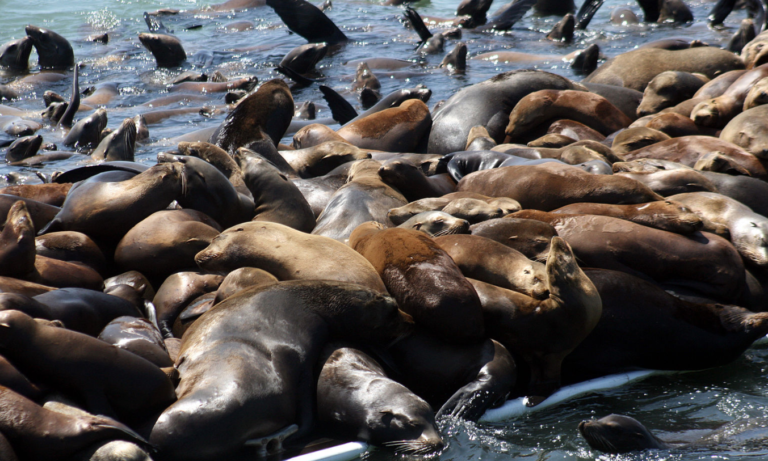California Coast's Toxic Algae Bloom: Impact On Marine Ecosystems

Table of Contents
The California coast, renowned for its breathtaking beauty and biodiversity, is facing a growing threat: toxic algae blooms. These harmful algal blooms (HABs), fueled by climate change and nutrient runoff, are significantly impacting marine ecosystems and raising serious concerns for the future of coastal California. This article explores the devastating effects of these blooms and what can be done to mitigate them.
<h2>Causes of Toxic Algae Blooms on the California Coast</h2>
Toxic algae blooms, also known as red tides (though not all HABs are red), are complex phenomena with multiple contributing factors. Understanding these causes is crucial for developing effective management strategies.
<h3>Nutrient Pollution</h3>
Excess nutrients, primarily nitrogen and phosphorus, act as fertilizer for algae, triggering rapid growth and bloom formation. This process, known as eutrophication, is significantly fueled by human activities:
- Agricultural runoff: Fertilizers used in agriculture wash into waterways, carrying excess nutrients to coastal areas.
- Wastewater discharge: Untreated or inadequately treated wastewater releases high levels of nutrients into the ocean.
- Urban stormwater runoff: Runoff from urban areas carries pollutants, including fertilizers and other nutrients, directly into the ocean.
The impact of this nutrient overload is undeniable. It creates conditions that favor the proliferation of harmful algae species over beneficial phytoplankton, disrupting the delicate balance of the marine ecosystem.
<h3>Climate Change</h3>
Climate change is exacerbating the problem of toxic algae blooms in several ways:
- Rising ocean temperatures: Warmer waters create ideal conditions for certain harmful algae species to thrive and produce toxins at higher rates.
- Changes in ocean currents: Altered currents can transport blooms over larger distances, expanding their impact area.
- Increased stratification of the water column: Warmer surface waters stratify, preventing mixing and trapping nutrients near the surface, further fueling algal growth.
The synergistic effect of rising temperatures and nutrient enrichment creates a perfect storm for HAB proliferation, increasing both frequency and intensity.
<h3>Natural Factors</h3>
While human activities are largely responsible for the increased frequency and severity of toxic algae blooms, natural factors also play a role:
- Upwelling events: Upwelling brings nutrient-rich water from the deep ocean to the surface, which can fuel algal growth. However, the intensified nutrient pollution from human sources supercharges this natural process.
- Seasonal variations: Certain algae species bloom seasonally, influenced by factors like sunlight, temperature, and water salinity.
- Natural variations in nutrient levels: While natural nutrient fluctuations occur, human activities significantly amplify these levels, creating conditions ripe for HABs.
<h2>Impact on Marine Life and Ecosystems</h2>
The consequences of toxic algae blooms on California's marine life and ecosystems are severe and far-reaching.
<h3>Direct Toxicity</h3>
Many marine organisms are directly poisoned by the toxins produced by harmful algae:
- Fish kills: Massive die-offs of fish are frequently observed during and after HAB events. Examples include anchovies, sardines, and other commercially important species.
- Shellfish contamination: Toxins accumulate in shellfish, such as mussels, clams, and oysters, posing significant risks to human consumers through bioaccumulation. This often leads to shellfish harvesting closures.
- Marine mammal and seabird mortality: Sea lions, whales, dolphins, and seabirds are vulnerable to HAB toxins. Exposure can cause neurological damage, respiratory problems, and death. For example, domoic acid poisoning from Pseudo-nitzschia species has caused significant mortality in sea lions.
<h3>Disrupted Food Webs</h3>
HABs disrupt the delicate balance of the marine food web:
- Reduced phytoplankton diversity: Harmful algae outcompete beneficial phytoplankton, the base of the food web, reducing food availability for zooplankton and other organisms.
- Decreased zooplankton populations: Zooplankton that feed on phytoplankton are directly affected by HABs, impacting the populations of fish and other animals that rely on them for food.
- Impact on predator-prey relationships: Disruptions cascade up the food web, affecting predator-prey relationships and potentially leading to population declines of various species, including commercially important fish.
<h3>Habitat Degradation</h3>
HABs cause significant habitat degradation:
- Oxygen depletion (hypoxia/anoxia): Decomposing algae consume large amounts of oxygen, creating "dead zones" where marine life cannot survive.
- Changes in water clarity: Blooms reduce light penetration, hindering photosynthesis by seagrasses and other marine plants, damaging vital underwater habitats.
- Impact on benthic communities: Changes in oxygen levels and light penetration have long-lasting effects on bottom-dwelling organisms, impacting biodiversity and ecosystem function.
<h2>Monitoring and Mitigation Strategies</h2>
Addressing the problem of toxic algae blooms requires a multi-pronged approach involving monitoring, mitigation, and public health measures.
<h3>Early Warning Systems</h3>
Developing and implementing advanced monitoring technologies is crucial:
- Satellite monitoring: Satellites provide a broad overview, detecting the presence and extent of blooms.
- In situ sensors: Sensors deployed in the water column provide real-time data on algal concentrations and toxin levels.
- Citizen science programs: Engaging the public in monitoring efforts can provide valuable data and increase awareness.
Early detection allows for timely implementation of mitigation strategies and public health advisories.
<h3>Reducing Nutrient Runoff</h3>
Reducing nutrient input is paramount:
- Improved agricultural practices: Implementing sustainable agricultural practices, such as reducing fertilizer use and adopting cover cropping, can significantly reduce nutrient runoff.
- Upgrading wastewater treatment: Investing in advanced wastewater treatment facilities to remove nutrients before discharge is essential.
- Controlling urban stormwater runoff: Implementing green infrastructure, such as rain gardens and permeable pavements, can help manage stormwater runoff and reduce nutrient pollution.
<h3>Public Health Measures</h3>
Protecting public health is crucial:
- Shellfish harvesting closures: Implementing timely closures of shellfish harvesting areas when toxins are detected protects human consumers.
- Public advisories: Issuing timely public advisories warning people about potential risks associated with HABs is vital.
<h3>Research and Collaboration</h3>
Continued research is essential:
- Understanding HAB dynamics: Further research is needed to improve our understanding of the factors that trigger and sustain HABs.
- Developing effective control measures: Research is ongoing to develop innovative and effective methods for controlling HABs.
- International collaboration: Sharing data and research findings internationally is crucial for a comprehensive understanding and effective management of HABs.
<h2>Conclusion</h2>
The increasing frequency and intensity of toxic algae blooms along the California coast pose a significant threat to marine ecosystems and human health. Understanding the causes, impacts, and potential mitigation strategies is crucial for protecting the invaluable biodiversity of the California coast. We must take immediate action to reduce nutrient pollution, mitigate climate change impacts, and enhance monitoring efforts. By working together, we can strive to minimize the effects of California's toxic algae blooms and safeguard the future of our precious coastal environment. Learn more about harmful algal blooms and how you can help protect the California coast by visiting your local environmental agency's website.

Featured Posts
-
 Dmps Cell Phone Policy A District Wide Approach For Next School Year
May 30, 2025
Dmps Cell Phone Policy A District Wide Approach For Next School Year
May 30, 2025 -
 Understanding Live Now Pay Later Services A Comprehensive Overview
May 30, 2025
Understanding Live Now Pay Later Services A Comprehensive Overview
May 30, 2025 -
 Uji Coba Kawasaki Versys X 250 2025 Performa Di Segala Medan
May 30, 2025
Uji Coba Kawasaki Versys X 250 2025 Performa Di Segala Medan
May 30, 2025 -
 Alastylae Ela 13 Hya Flstynya Waqe Mqawmt Aljdar Walastytan
May 30, 2025
Alastylae Ela 13 Hya Flstynya Waqe Mqawmt Aljdar Walastytan
May 30, 2025 -
 Dublin 2026 Metallicas Weekend Concert At Aviva Stadium
May 30, 2025
Dublin 2026 Metallicas Weekend Concert At Aviva Stadium
May 30, 2025
Latest Posts
-
 Discounted Spring Hotel Stays Up To 30 Off Lavish Hotels
May 31, 2025
Discounted Spring Hotel Stays Up To 30 Off Lavish Hotels
May 31, 2025 -
 Exploring The Boundaries Of Ai Learning Towards Responsible Ai Development And Deployment
May 31, 2025
Exploring The Boundaries Of Ai Learning Towards Responsible Ai Development And Deployment
May 31, 2025 -
 Responsible Ai Acknowledging The Limits Of Ai Learning Capabilities
May 31, 2025
Responsible Ai Acknowledging The Limits Of Ai Learning Capabilities
May 31, 2025 -
 Exploring The Boundaries Of Ai Learning A Path To Responsible Ai
May 31, 2025
Exploring The Boundaries Of Ai Learning A Path To Responsible Ai
May 31, 2025 -
 Up To 30 Off Your Luxurious Spring Hotel Awaits
May 31, 2025
Up To 30 Off Your Luxurious Spring Hotel Awaits
May 31, 2025
